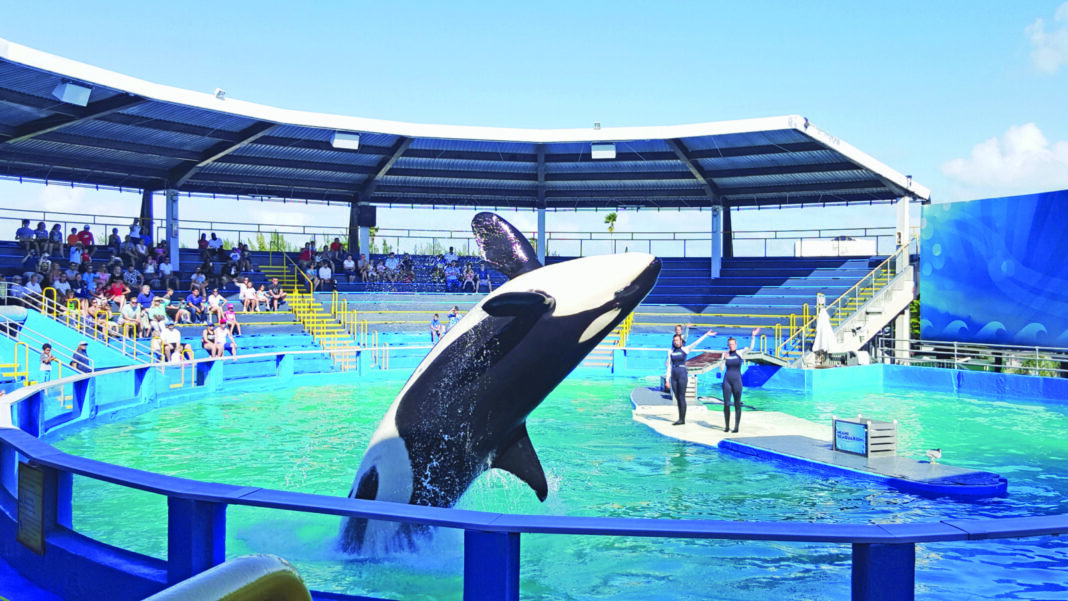On March 30, an announcement from the Miami Seaquarium shook the marine mammal training world to its core as the facility announced plans to relocate its lone killer whale Tokitae, colloquially known as Lolita, to an ocean sanctuary or sea pen in the Pacific Northwest. Captured in 1970 near that area, Tokitae is believed to be the oldest or second-oldest orca in human care at roughly 57 years old.
The announcement comes with news of a binding agreement between the Dolphin Company, which announced its purchase of the Miami Seaquarium in August 2021, and Friends of Lolita, a nonprofit dedicated to “helping” the whale.
Before we continue, I won’t lie: I was an animal trainer for nearly seven years, and I will defend the ability of animals in human care to inspire curiosity, wonder, and a desire to conserve our oceans and all their creatures to my last breath. If this newspaper was the Miami Weekly, this opinion column would be a four-page investigative journalism piece. It’s not one that I enjoy writing, and the layers to the decades-long legal battles surrounding this beloved whale are absolutely mind-boggling.
The announcement is the latest chapter in the book of ways in which the corporations and governments responsible for Tokitae’s care have failed her throughout her entire life. And at the end of the day, it’s too little, too late.
Captured from the wild at approximately age four, the 22-foot, four-ton whale resides in a 20-foot-deep tank with its largest section measuring 80 feet by 35 feet. Thankfully, it’s a situation that should never be repeated again, as the U.S. has not issued a permit to collect a wild killer whale since 1989, and current standards for whale pools are not what they were decades ago. But even as a lover of accredited zoos and aquariums, seeing her in this pool in person for the first time several years ago was jarring, to say the least.
When the Seaquarium planned a $40 million expansion in the 1990s to include Tokitae’s pool and create a more suitable habitat, her own Key Biscayne neighbors brought the park to court – and won. A 2022 U.S. Department of Agriculture report sharply criticized the facility – the Animal and Plant Health Inspection Service (APHIS), a USDA agency, is responsible for inspecting animal care facilities – but in the same year, the agency granted a new exhibitor’s license to a subsidiary of the Dolphin Company as it purchased the facility – under the condition that Tokitae was removed from public display.
There’s a reason the March 30 announcement has been widely denounced throughout the zoological community, particularly by Tokitae’s former trainers, veterinarians and other care professionals. There’s a reason #truth4toki is trending as a wealth of firsthand accounts from those who know her best fill the internet via posts, podcasts and “tell-all” videos, chronicling the writing on the wall in the months prior to this announcement and begging the Seaquarium to reverse its course.
There’s a reason why the dedicated team directly caring for Tokitae celebrates each new day: every sunrise is a record-breaking occurrence for one of the oldest killer whales ever in human care fast approaching the age of 60, especially with a highly-publicized health scare in 2022.
A health and welfare assessment released on March 31 by veterinarians James McBain and Stephanie Norman described her as “relatively stable” while barely opening the door for “some optimism to enter the discussion.” She receives daily antibiotics and antifungal medications. A journey across the continent to an entirely new environment after more than 50 years is treacherous, to say the least, especially with an animal described by her trainers as a creature of habit who does not do well with change.
There’s a reason why widely-accredited agencies like the International Marine Animal Trainers Association (IMATA) released statements on the announcement, carefully noting the absence of an “actionable, science-based plan” at the “publicity event.” A Q&A published by NOAA fisheries noted that the Seaquarium has yet to submit any formal proposal to move or release Tokitae, and that any such move would face regulatory hurdles. A statement by the Animal Behavior Management Alliance (ABMA) said “the announcement did not include any science-based details, logistics, explanations or risk assessments that would be relevant to their relocation plan.”
These organizations will tiptoe. I won’t.
Add it all up, and this reeks of a publicity stunt that serves as a convenient final chapter for a commodity that holds no further financial value to a large corporation with more than 30 parks around the globe. I pray the circle of life won’t catch up to Tokitae in this process, but let’s call it like it is: headlines will be kinder about a death that occurs during the pursuit of “freedom” than they would be if she stays in her current home.
Further sweetening the deal is the fact that the estimated eight-figure cost of moving the company’s financial deadweight will be bankrolled by philanthropists like Jim Irsay. (I’d love to sit down with the NFL owner and see just how much he knows about animal care, or ask how his support of the move squares with his $1 million donation to the Indianapolis Zoo a few months ago, but that’s another story.)
To be clear, netted seawater lagoons can be wonderful environments full of phenomenal natural enrichment for their residents, as facilities like Dolphin Research Center, Dolphins Plus and Dolphin Connection here in the Keys demonstrate. But for an animal of Tokitae’s age, a move like this is akin to removing your grandmother from a nursing home in favor of semi-supervised jaunts in the woods. Maybe the idea would have been viable decades ago. It’s not now.
To those who champion the idea of taking the current plan a step further to a full release for Tokitae as a true “Free Willy” story – as suggested by Irsay – let’s recall how that “true story” ended: in the only attempt thus far to reintroduce a killer whale to the wild after significant time in human care, the star of the movie, 27-year-old Keiko, died in a Norwegian bay after less than two years of full freedom. He never successfully re-integrated with any other orcas – a possibility romanticized for Tokitae’s move as some speculate about a reunion with her original family – and while he did re-learn to feed himself somewhat, he consistently returned to humans for food and companionship. Capitulating to anti-captivity activists and re-attempting this process with a whale three decades older than Keiko sets a dangerous precedent for a practice that has yet to find any measure of consistent success.
So before we rejoice over the move, let’s consider whether it’s truly in the best interest of a geriatric animal accustomed to 50 years of a consistent routine to attempt one of the most ambitious animal moves ever undertaken. It’s true her current home is inadequate, but sadly, the true chance to remedy that injustice died in courtrooms years ago.
If nothing else, I can hope we at least agree that this magnificent animal deserves so much more than to be martyred for a flawed cause in a business move by people who barely know her, all because it will provide for a more palatable end in the press.
Tokitae deserves so much more than that.
Have thoughts? Let’s talk! Alex@keysweekly.com.























